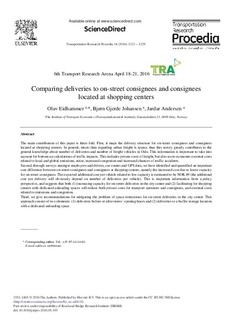| dc.contributor.author | Eidhammer, Olav | |
| dc.contributor.author | Johansen, Bjørn G. | |
| dc.contributor.author | Andersen, Jardar | |
| dc.coverage.spatial | Norway | nb_NO |
| dc.date.accessioned | 2019-06-26T14:02:20Z | |
| dc.date.available | 2019-06-26T14:02:20Z | |
| dc.date.created | 2016-09-05T12:19:53Z | |
| dc.date.issued | 2016-06-27 | |
| dc.identifier.citation | Transportation Research Procedia. 2016, 14, 1221-1229. | nb_NO |
| dc.identifier.issn | 2352-1465 | |
| dc.identifier.uri | http://hdl.handle.net/11250/2602400 | |
| dc.description.abstract | The main contribution of this paper is three-fold. First, it maps the delivery structure for on-street consignees and consignees located at shopping centers. In general, micro-data regarding urban freight is sparse, thus this survey greatly contributes to the general knowledge about number of deliveries and number of freight vehicles in Oslo. This information is important to take into account for bottom-up calculations of traffic impacts. This includes private costs of freight, but also socio-economic external costs related to local and global emissions, noise, increased congestion and increased chances of traffic accidents.
Second, through surveys amongst employees and drivers, car counts and GPS data, we have identified and quantified an important cost difference between on-street consignees and consignees at shopping centers, namely the increased cost due to lower capacity for on-street consignees. The expected additional cost per vehicle related to low capacity is estimated to be NOK 49 (the additional cost per delivery will obviously depend on number of deliveries per vehicle). This is important information from a policy perspective, and suggests that both (1) increasing capacity for on-street deliveries in the city center and (2) facilitating for shopping centers with dedicated unloading spaces will reduce both private costs for transport operators and consignees, and external costs related to emissions and congestion.
Third, we give recommendations for mitigating the problem of space restrictions for on-street deliveries in the city center. This approach consist of two elements: (1) deliveries before or after stores’ opening hours and (2) deliveries to a buffer storage location with a dedicated unloading space. | nb_NO |
| dc.language.iso | eng | nb_NO |
| dc.publisher | Elsevier | nb_NO |
| dc.rights | Attribution-NonCommercial-NoDerivatives 4.0 Internasjonal | * |
| dc.rights.uri | http://creativecommons.org/licenses/by-nc-nd/4.0/deed.no | * |
| dc.title | Comparing Deliveries to On-street Consignees and Consignees Located at Shopping Centers | nb_NO |
| dc.title.alternative | Comparing Deliveries to On-street Consignees and Consignees Located at Shopping Centers | nb_NO |
| dc.type | Journal article | nb_NO |
| dc.type | Peer reviewed | nb_NO |
| dc.rights.holder | © 2016 The Authors. Published by Elsevier B.V. | nb_NO |
| dc.description.version | publishedVersion | nb_NO |
| cristin.unitcode | 7482,3,4,0 | |
| cristin.unitcode | 7482,3,3,0 | |
| cristin.unitname | Logisikk og innovasjon | |
| cristin.unitname | Næringslivets transportbehov | |
| cristin.ispublished | true | |
| cristin.fulltext | original | |
| cristin.qualitycode | 1 | |
| dc.identifier.doi | 10.1016/j.trpro.2016.05.193 | |
| dc.identifier.cristin | 1378105 | |
| dc.source.journal | Transportation Research Procedia | nb_NO |
| dc.source.volume | 14 | nb_NO |
| dc.source.pagenumber | 1221-1229 | nb_NO |

